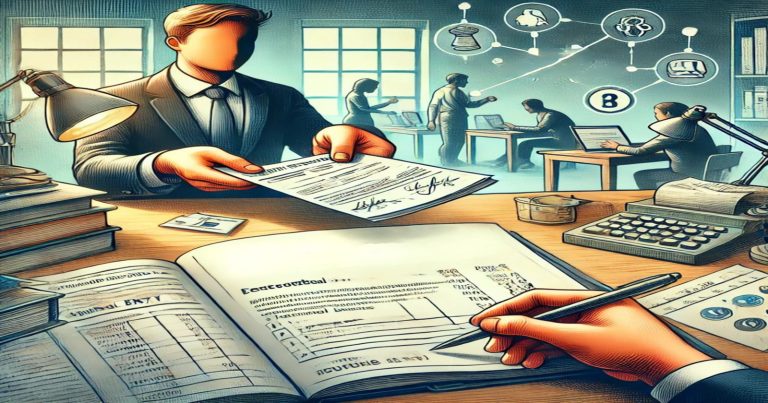A bill receivable is created when a business sells goods or performs services and receives a written promise to be paid at a future date. The journal entry of bills receivable is to record this transaction in the books. This journal entry can be made by debiting Bills Receivable Account and crediting Debtor’s Account. That means the business will receive money on a future date, it then becomes an asset. In this article, you can learn about the bills receivable meaning, the format, how to record it, and the bills receivable vs bills payable difference.
What Are Bills Receivable in Accounting?
Bills receivable is a written promise that a business will receive a fixed amount of money from someone on a specific future date. It is a legal document. A business receives this Promise and treats it as an asset. to put it another way, a bill receivable, is an asset for the seller when a customer buys goods with an agreement to pay with a bill of exchange. Bills receivable are common on credit sales. The seller gets a bill of exchange and not cash right away. This document is signed by the buyer as a promise to pay later. This becomes part of the company’s current assets in accounting because it will become cash in the short term.
Use of Bills Receivable in Real Business
Bills receivable are used by businesses to control cash flow. A Company sells goods to a customer worth ₹50,000. Today, the customer cannot pay, but it agrees to pay after 90 days. The seller demands a bill of exchange. Once the customer signs this document, offered by the seller as a bill receivable. This process allows the seller to be certain they will get paid. It also provides legal evidence should the buyer default. Bills receivable is a very common business scenario in Indian businesses, especially the wholesale and manufacturing segments.
Role of Bills Receivable in Accounting
- It aids in tracking money the business anticipates receiving.
- It helps keep the business accounts accurate and complete.
- It minimizes the risk of making a loss due to nonpayment.
- This enables legal action if the bill is not honored.
Bill Receivable in Ledger Format
| Date | Particulars | L.F. | Debit (₹) | Credit (₹) |
| 01-Apr-25 | Debtor A/C | 101 | ₹50,000 | |
| To Bills Receivable A/C | 102 | ₹50,000 |
Here is the journal book or ledger bills receivable format.
Accounts Receivable in Accounting Terminology
According to books, the bills receivable appear as a current asset in the balance sheet. It displays the bills accepted by customers, its worth When the customer payment gets received, now the bill receivable becomes cash. If this customer does not pay, the business has to cancel the bill and do something.
Journal Entry for Bills Receivable with Examples
In this section, we present how to make an entry for bills receivable in the journal with examples. One of the common questions from the students is that “How to record bills receivable? Lets understand and make a journal entry passage for bills receivable.
Journal Entry for Bills Receivable at the Time of Acceptance of Bill
When the buyer receives the signed bill from the seller, the entry is:
Bills Receivable A/C Dr.
To Debtor’s A/C
That is, we deduct the amount from the debtor’s account and add it to the bills receivable account.
Example: ABC Ltd. sold goods on credit to Mr. Raj amounting to ₹1,00,000. Mr. Raj accepted a bill of exchange for payment after 3 months. This is a journal entry about accepting the bill.
Journal Entry on Bill Acceptance:
| Date | Particulars | L.F. | Debit (₹) | Credit (₹) |
| 01-Mar-25 | Bills Receivable A/C Dr. | 201 | ₹1,00,000 | |
| To Mr. Raj A/C | 202 | ₹1,00,000 |
This just records that Mr. Raj now owes via a formal bill.
Bill Receivable Accounting at Maturity
At the time of payment by customer on due date:
Bank A/C Dr.
To Bills Receivable A/C
Example: On 01-June-2025, Mr. Raj paid the bill.
Journal Entry:
| Date | Particulars | L.F. | Debit (₹) | Credit (₹) |
| 01-Jun-25 | Bank A/C Dr. | 301 | ₹1,00,000 | |
| To Bills Receivable A/C | 302 | ₹1,00,000 |
The bill is now cleared. The said amount has been credited in the bank.
When the Bill Is Dishonored
If the buyer fails to pay the bill on its due date:
Debtor’s A/C Dr.
To Bills Receivable A/C
(Added, occasionally, noting charges.)
Example: Mr. Raj did not pay the bill. Charges of ₹500 paid – it is noted.
Journal Entry:
| Date | Particulars | L.F. | Debit (₹) | Credit (₹) |
| 01-Jun-25 | Mr. Raj A/C Dr. | 401 | ₹1,00,500 | |
| To Bills Receivable A/C | 402 | ₹1,00,000 | ||
| To Bank A/C (Charges) | 403 | ₹500 |
This returns the bill to the debtor’s account.
Bills Receivable vs Bills Payable
When it comes to business, bills receivable and bills payable is a fundamental concept that you should be aware of. These two terms are similar in appearance but they are antonyms. Both are components of accounting for credit transactions. This is something students should be well aware of when it comes to correctly answering examinations and real-life queries.
| Basis | Bills Receivable | Bills Payable |
| Role in Transaction | Amount to be received | Amount to be paid |
| Nature | Asset | Liability |
| Position in Balance Sheet | Current Assets | Current Liabilities |
| Recorded By | Seller (Creditor) | Buyer (Debtor) |
| Example | Seller gets bill from buyer | Buyer gives bill to seller |
Receivable from bills — an accounting record showing the promise to receive funds. Bills payable, on the other hand, refers to the liability to pay money to others. Bills payable for any business is when a company receives a bill and agrees to pay it. While for the giver of the amount, it is accounts receivable but for the receiver of the amount, it is a bills receivable.
Example of Bills Receivable and Bills Payable in Real Life
Let us say Rahul Textiles sells goods worth ₹75,000 to Aarav Traders. Fact: Aarav Bill is a “Payable in 60 days” acceptance.
For Rahul Textiles: It is a receivable bills.
Rahul will record it as:
Bills Receivable A/C Dr.
To Aarav Traders A/C
For Aarav Traders: It was a bills payable.
Aarav will record it as:
Rahul Textiles A/C Dr.
To Bills Payable A/C
This is the double entry system of the bills receivable On both sides the transaction entry is made for equal value in your books.
Relavance to ACCA Syllabus
Bills Receivable Journal Entry is a substantial topic in ACCA for Financial Accounting and Financial Reporting papers. Students must learn how to identify and record trade receivables in the books. This area may be most important for journal entries and adjusting, as well as how they interpret financial statements. It connects with IFRS 9 – Financial Instruments and helps students understand how real businesses present and measure receivables.
Bills Receivable Journal Entry ACCA Questions
Q1: What is the journal entry for receiving a bill against a debtor?
A) Debit Bills Payable, Credit Debtor
B) Debit: Debtor, Credit: Bills Receivable
C) Debit Bills Receivable, Credit Debtor
D) Debit Cash, Credit Debtor
Ans : C) Bills Receivable Dr, Debtor Cr
Q2: Which IFRS governs the recognition of bills receivable?
A) IFRS 7
B) IFRS 9
C) IFRS 15
D) IFRS 10
Ans: B) IFRS 9
Q3: How to record in the journal when a bill is dishonored?
A) Debit Debtor, Credit Bills Receivable
B) Debit Bills Receivable, Credit Debtor
C) Debit Debtor, Credit Bank
D) Debit Bank, Credit Debtor
Ans: A) Debit Debtor, Credit Bills Receivable
Q4: Which statements of financial position contains bill receivable?
A) Income Statement
B) Statement of Cash Flows
C) Balance Sheet
D) Change in Equity Statement
Ans: C) Statement of Financial Position
Q5: Which of the following statements regarding bills receivable is not correct?
A) It is a current asset
B) It replaces a credit sale
B) Data is up to October of 2023.
D) It can be discounted
Ans: C) It is non-negotiable always
Relevance to US CMA Syllabus
The syllabus for the US CMA includes Accounting fundamentals under Financial Reporting. The bills receivable is an important part of the analysis of current assets and in examining the liquidity and receivable turnover ratios. In addition, this concept assists candidates in understanding and spotting recognition of revenue and valuation of receivables, which are been tested in the Part 1 of the CMA exam: Financial Planning, Performance, and Analytics.
Bills Receivable Journal Entry CMA Questions
Q1: Bills Receivable is in which category of the balance sheet?
A) Long-term Liabilities
B) Current Liabilities
C) Non-current Assets
D) Current Assets
Ans: D) Current Assets
Q2: What does it mean when a company discounts a bill receivable?
A) Bills Receivable increases
B) Bank debit, Bills Receivable credit
C) Accounts Receivable goes up
D) Debtor account is reopened
Ans: B) Bank debit, Bills Receivable credit
Q3: How does collection of bill receivable impact working capital?
A) No impact
B) Working capital increases
C) Working capital decreases
D) Working capital doubles
Ans: A) No impact
Q4: What is the internal control that best guards bills receivable?
A) Authorization and recording are separate
B) Usage of electronic invoicing
C) Outsourcing receivables
D) Physical stocktaking
Ans: (A) Separation of authority and recording
Q5: In cash flow statement, the treatment of bills receivable is:
A) Operating Activities
B) Investing Activities
C) Financing Activities
D) None of the above
Ans: A) Operating Activities
Relavance to US CPA Syllabus
Bills receivable may show up on the CPA exam in FAR (Financial Accounting and Reporting). This is specifically with reference to receivables related items and how they tend to be classified, recognized, measured, and presented (U.S. GAAP framework context). Knowledge of journal entries for bills receivable is crucial for ensuring accurate financial reporting and reconciling accounts.
Bills Receivable Journal Entry CPA Questions
Q1: How would a bill receivable be measured at initial recognition in accordance with US GAAP?
A) Market Value
B) Present Value
C) Face Value
D) Replacement Cost
Ans: C) Face Value
Q2: Which of these are most appropriate to a bill receivable?
A) A short-term liability
B) A promise to pay
C) A long-term investment
D) A contingent asset
Ans: B) A promise to pay
Q3: How does dishonoring of a bill affects financial statements?
A) Asset increases
B) No effect
C) Accrual to Accounts Receivable
D) Increases liabilities
Ans: C) Reversal of Accounts Receivable
Q4: In the U.S. GAAP classified balance sheet, where do bills receivable go?
A) Under Non-current assets
B) Under Intangible assets
C) Under Cash Equivalents
D) Under Current assets
Ans: D) Under Current assets
Q5: What event will have no effect on bills receivable?
A) Collection of bill
B) Dishonor of bill
C) Issue of bill to debtor
D) Payment to creditor
Ans: D) Payment to creditor
Relevance to CFA Syllabus
Bills receivable is tied in with financial statements, revenue recognition and current asset value IFRS and GAAP as per CFA Level 1. CFA students explore the impact of receivables on liquidity, working capital, and financial health. You will be tested on these skills in FRA as well as in Equity Investments when assessing strength of a company.
Bills Receivable Journal Entry CFA Questions
Q1: Which ratio is most impacted by bills receivable?
A) Debt-to-equity
B) Receivables Turnover
C) Gross Profit Margin
D) Interest Coverage
Ans: B) Receivables Turnover
Q2: A large bills receivable balance would be an indicator in financial analysis:
A) Strong collection policy
B) High cash reserves
C) Weak receivables management
D) Excessive inventory
Ans: C) Poor receivables management
Q3: What are bills receivable and how are they treated in financial models?
A) As an equity item
B) As a non-operating income
C) As a non-operating asset
D) As a contemporary living asset
Ans: D) Current Operating Asset
Q4 What Adjustment Must be Made in Case Bill Receivable is Dishonored?
A) Increase liability
B) Reduce equity
C) Reverse asset and reinstate receivable
D) Adjust revenue
Correct Answer: C) Reverse the asset & reinstate receivable
Q5: What changes in accounting when a bill is discounted?
A) Liabilities increase
B) Receivables increase
C) Cash goes up, receivables go down
D) Revenue increases
Ans: C) Cash will increase, Receivables will decrease


